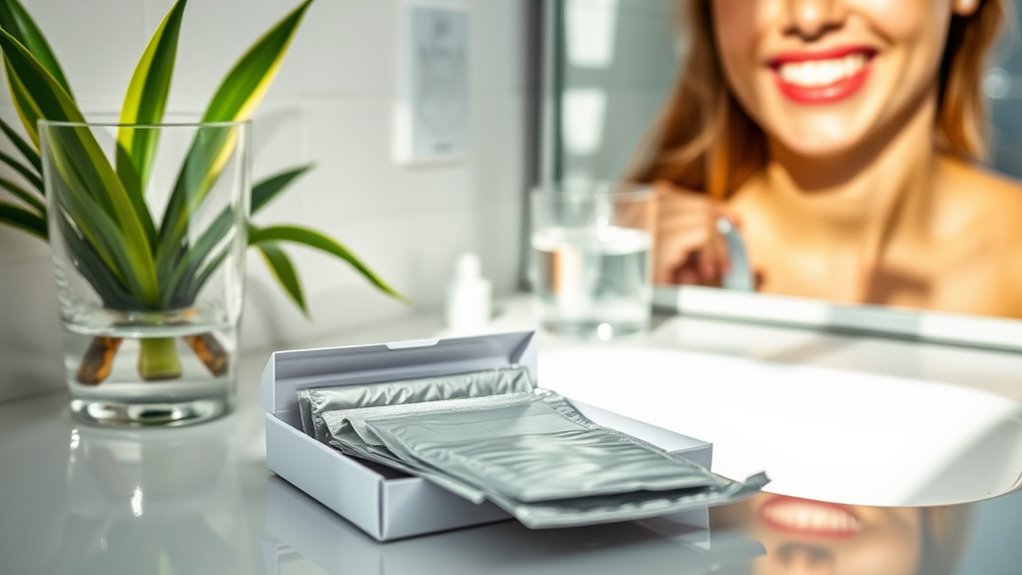The Truth About Whitening Strips- Do They Work.
When it comes to whitening strips, you might wonder if they really deliver on their promises. These products typically use peroxide agents to break down stains on your teeth, often showing results in just a few days. However, while they offer convenience and affordability, there are important risks to consider, such as sensitivity and potential enamel damage. Understanding these factors is crucial before you decide if they’re the right choice for you.
Key Takeaways
- Whitening strips effectively lighten teeth by using peroxide-based agents that penetrate enamel to break down stains, yielding noticeable results in a few days.
- Users report increased confidence and brighter smiles with consistent use, making strips a convenient alternative to professional whitening treatments.
- Tooth sensitivity and gum irritation are common risks, with approximately 30% of users experiencing sensitivity that typically resolves after discontinuation.
- Overuse of whitening strips can lead to enamel thinning and long-term dental damage, highlighting the importance of following usage instructions.
- To maintain results, users should incorporate good oral hygiene practices and avoid foods and drinks that cause staining after using the strips.
Understanding How Whitening Strips Work
How do whitening strips actually brighten your smile? These strips contain peroxide-based whitening agents that penetrate enamel to break down stains.
When applied, they adhere to your teeth, allowing the active ingredients to work effectively. A whitening strips review often highlights their convenience and ease of use, making them popular among those seeking a brighter smile.
Typically, you’ll wear them for a specified time, and consistent use can lead to noticeable results. It’s essential to follow the instructions for optimal effectiveness and to minimize potential sensitivity. However, the impact of whitening strips on tooth enamel should not be overlooked, as it can lead to long-term dental health issues.
Ultimately, understanding how these strips function can help you achieve the smile you desire.
Benefits of Using Whitening Strips
Many people find that using whitening strips offers a range of benefits for their dental care routine.
These strips provide a convenient, at-home solution for achieving a brighter smile without the need for professional treatments. They’re easy to use and typically require only a few applications to see noticeable results.
Many whitening strips contain hydrogen peroxide or carbamide peroxide, which effectively break down stains on tooth enamel.
Additionally, they can boost your confidence by enhancing your smile, making you feel more comfortable in social situations. However, it is important to be aware that frequent use risks lasting damage to your enamel and may lead to increased sensitivity.
Potential Drawbacks and Risks
While whitening strips can enhance your smile, they may also come with potential drawbacks.
You might experience tooth sensitivity or gum irritation after use, which can be uncomfortable. Additionally, overuse of whitening agents can lead to enamel thinning, increasing the risk of long-term dental damage.
It’s essential to weigh these risks against the benefits before deciding to use them.
Tooth Sensitivity Issues
Have you ever noticed increased tooth sensitivity after using whitening strips?
This common issue arises due to the active ingredients, like hydrogen peroxide, which can penetrate enamel and irritate the nerves inside your teeth.
Studies show that about 30% of users experience some level of sensitivity during or after treatment.
While this sensitivity usually subsides shortly after discontinuing use, it can be uncomfortable.
To minimize this risk, consider using strips with lower concentrations, applying them less frequently, or opting for desensitizing toothpaste.
Always consult your dentist if sensitivity persists, ensuring your dental health remains a priority.
Gum Irritation Risks
Gum irritation is a common concern for those using whitening strips, as the active ingredients can sometimes cause inflammation or discomfort in the gums.
If you notice redness, swelling, or bleeding after using these products, it’s essential to stop using them immediately.
Overuse or improper application can exacerbate these symptoms.
To minimize risks, follow the manufacturer’s instructions carefully and limit usage to recommended durations.
Additionally, consult your dentist before starting any whitening regimen, especially if you have pre-existing gum issues.
Being proactive can help ensure a safer experience while achieving the bright smile you desire.
User Experiences and Testimonials
Many users report positive experiences with whitening strips, noting noticeable improvements in the brightness of their smiles.
Many appreciate how easy they’re to use and incorporate into their daily routines.
Here are some common feedback points:
- Quick Results: Many users see effects within a few days, boosting their confidence.
- Convenience: Strips can be applied at home, making them a flexible option for busy lifestyles.
- Affordability: Compared to professional treatments, whitening strips provide a cost-effective solution for achieving a whiter smile.
These testimonials suggest that whitening strips can indeed be an effective choice for many individuals. However, it’s important to consider that natural ingredients can still harm tooth enamel and irritate gums if used improperly.
Comparing Whitening Strips to Other Whitening Methods
While whitening strips offer a convenient and cost-effective solution for brightening your smile, it’s essential to compare them with other whitening methods to determine which is best for your needs.
Professional treatments, like in-office bleaching, often yield faster and more dramatic results but come at a higher cost.
Custom trays filled with whitening gel provide a balance between effectiveness and convenience, though they require more time to achieve results.
Additionally, natural remedies, like baking soda or activated charcoal, may be less effective and could harm enamel.
Assessing your budget, time, and desired outcome will help you make an informed choice. Moreover, it’s crucial to consider that proper dental hygiene post-whitening is essential to maintain your results and overall oral health.
Tips for Effective Use of Whitening Strips
To get the best results from whitening strips, it’s crucial that you follow the instructions carefully. Stick to a consistent application schedule to maintain the whitening effects, and be mindful of avoiding foods that could stain your teeth. Additionally, be aware that overusing whitening products can lead to enamel erosion and increased tooth sensitivity.
Follow Instructions Carefully
Following the instructions provided with whitening strips is crucial for achieving the best results and ensuring your safety.
To maximize effectiveness, keep these tips in mind:
- Timing: Adhere to the recommended wear time. Wearing strips longer won’t enhance results and may increase sensitivity.
- Clean Teeth: Brush your teeth before application. This helps remove plaque and allows the whitening agents to penetrate better.
- Avoid Eating or Drinking: Refrain from consuming anything for at least 30 minutes after using the strips to allow the whitening agents to work effectively.
Consistent Application Schedule
Consistently applying whitening strips is essential for achieving noticeable results in your teeth whitening journey. Establishing a regular schedule not only maximizes effectiveness but also helps maintain results over time. Here’s a simple guide to help you stay on track:
| Day | Strip Application | Notes |
|---|---|---|
| Day 1 | 1st Application | Morning or evening |
| Day 2 | 2nd Application | Same time as Day 1 |
| Day 3 | 3rd Application | Maintain consistency |
| Day 4 | 4th Application | Check for sensitivity |
Stick to your schedule for the best outcome!
Avoid Food Stains
While you’re using whitening strips, it’s crucial to avoid food stains that can counteract your efforts.
Certain foods and beverages can hinder your whitening results, so be mindful of your choices.
Here are three tips to help you maintain your bright smile:
- Limit dark beverages: Reduce intake of coffee, tea, and red wine, as they can easily stain your teeth.
- Steer clear of staining foods: Avoid berries, soy sauce, and tomato sauce during your treatment.
- Rinse with water: After consuming any staining foods or drinks, rinse your mouth with water to minimize contact.
These steps can enhance your whitening results.




